
Goodenia hederacea, commonly known as forest goodenia or ivy goodenia, is a species of flowering plant that is endemic to eastern Australia. It is a prostrate to ascending, perennial herb with linear to elliptic or round leaves, and racemes of yellow flowers.
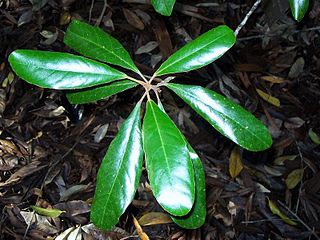
Elaeocarpus williamsianus, commonly known as hairy quandong, is a species of flowering plant in the family Elaeocarpaceae and is endemic to a restricted area of north-eastern New South Wales. It is a small tree with lance-shaped leaves, racemes of greenish-white flowers and spherical blue fruit.
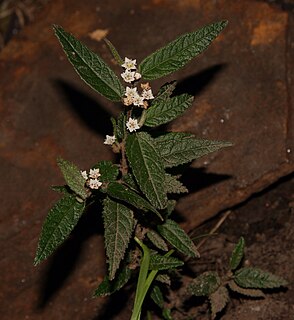
Commersonia dasyphylla, commonly known as kerrawang, is a species of shrub of the family Malvaceae native to eastern Australia. It was initially described by Henry Cranke Andrews as Commersonia dasyphylla in 1810, and then placed in the genus Rulingia by Robert Sweet in 1826 where it remained until its original name was restored in 2011. The genus name commemorates 18th-century French naturalist Philibert Commerson, while the species name is derived from Ancient Greek dasys "hairy" and phyllon "leaf", and refers to cottonlike hairs covering the leaves.

Androcalva fraseri, commonly known as blackfellow's hemp or brush kurrajong is a common shrub or small tree of the mallow family found in eastern Australia. Growing up to 8 metres tall, it is found in rainforest margins and in wet eucalyptus forests.

Prostanthera cryptandroides is a species of flowering plant in the family Lamiaceae and is endemic to eastern Australia. It is a low, spreading shrub with narrow egg-shaped leaves and lilac to mauve flowers arranged singly in leaf axils.
Persoonia prostrata is a plant in the family Proteaceae and is endemic to the northern tip of Fraser Island in Queensland, but is presumed to be extinct. It is similar to Persoonia stradbrokensis but is a prostrate shrub with smaller leaves and flowers.

Persoonia procumbens is a plant in the family Proteaceae and is endemic to part of the New England Tableland. It is a prostrate shrub with rather fleshy, relatively large leaves and small groups of cylindrical yellow flowers. It is similar to P. daphnoides but has darker hairs on the young branches and smaller, less hairy flowers.

Androcalva is a genus of flowering plants in the family Malvaceae. The genus was first formally described in 2011 and comprises species formerly included in Commersonia (22) and Rulingia (4) as well as 7 new species.

Persoonia daphnoides is a plant in the family Proteaceae and is endemic to a restricted area near the border of eastern New South Wales and Queensland. It is a prostrate shrub with spatula-shaped to egg-shaped leaves with the narrower end towards the base, and yellow flowers in groups of up to eight on a rachis up to 35 mm (1.4 in) long.

Persoonia microphylla is a plant in the family Proteaceae and is endemic to New South Wales. It is an erect to prostrate shrub with elliptic to egg-shaped leaves and yellow flowers in groups of up to fourteen on a rachis up to 30 mm (1.2 in) long.
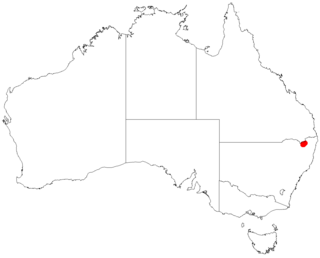
Prostanthera staurophylla, commonly known as Tenterfield mint-bush, is a species of flowering plant in the family Lamiaceae and is endemic to a small area on the New England Tableland of New South Wales. It is an erect to spreading, strongly aromatic shrub with hairy branches, deeply lobed leaves and bluish-mauve flowers with darker markings.

Commersonia hermanniifolia, commonly known as wrinkled kerrawang, is a species of flowering plant in the family Malvaceae and is endemic to New South Wales. It is a prostrate or trailing shrub with oblong to lance-shaped leaves that are paler on the lower surface, and flowers with five white sepals fading to pink and five pinkish petals.
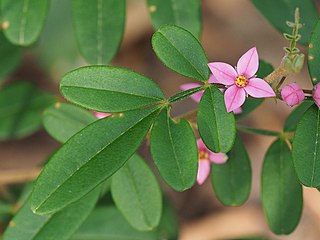
Boronia umbellata, commonly known as the Orara boronia, is a plant in the citrus family Rutaceae and is endemic to a small area on the north coast of New South Wales. It is an erect shrub with many branches, aromatic, pinnate leaves and clusters of up to ten dark pink flowers in the leaf axils.
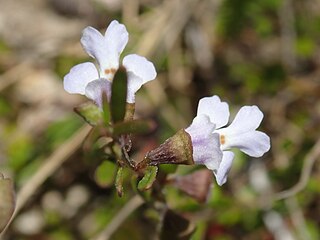
Prostanthera junonis, commonly known as Somersby mintbush, is a species of flowering plant in the family Lamiaceae and is endemic to the Central Coast of New South Wales. It is a low, straggling shrub with hairy, egg-shaped leaves and purple to mauve flowers.
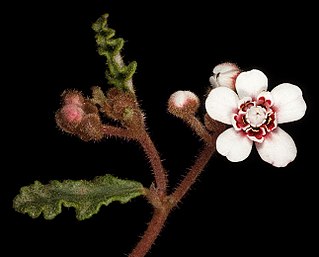
Androcalva pulchella is a shrub in the family Malvaceae. It is native to Western Australia.

Commersonia amystia is a species of flowering plant in the family Malvaceae and endemic to eastern Australia. It is a dwarf shrub with narrow egg-shaped leaves that are densely covered with star-like hairs on the lower surface, and has flowers with five white sepals that turn pink as they age, and five smaller white petals.
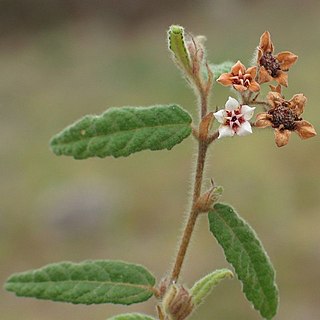
Commersonia breviseta is a species of flowering plant in the family Malvaceae and endemic to eastern Australia. It is a dwarf shrub with densely-hairy, egg-shaped to narrow elliptic leaves that are paler on the lower surface, and flowers with five white sepals with pink edges, five smaller pale yellow petals and dark red stamens.

Goodenia gibbosa is a species of flowering plant in the family Goodeniaceae and is endemic to central Australia. It is a prostrate to low-lying, often stoloniferous herb covered with soft hairs. It has elliptic to lance-shaped leaves and small groups of yellow flowers.
Goodenia lyrata is a species of flowering plant in the family Goodeniaceae and is endemic to inland areas of Western Australia. It is a prostrate herb with densely hairy, lyrate leaves at the base of the plant, smaller leaves on the stem and racemes of yellow flowers.
Goodenia megasepala is a species of flowering plant in the family Goodeniaceae and is endemic to Queensland. It is a prostrate to low-lying herb with toothed or lobed, lance-shaped to narrow elliptic leaves, and racemes of yellow flowers.



















